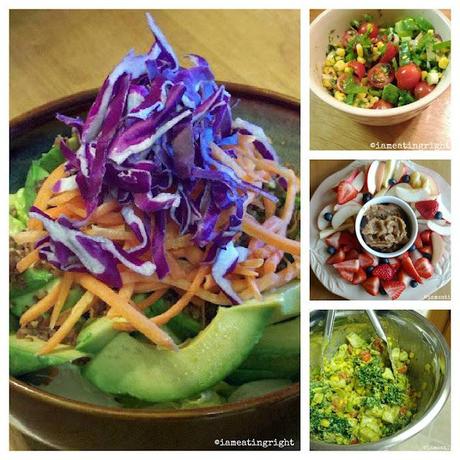****************************************************************
What is a raw whole-food plant-based diet? Also known as a raw vegan diet, here are some of its guiding principles:
- Foods are not heated above 118oF (47.7oC). So you’re not forced to eat only cold food; it can be warmed!
- Foods heated above 118oF are believed to have lost nutritional value and therefore are not as potent.
- Food can be frozen depending on the raw foodist to whom you are speaking. This is an area of debate because the viability of frozen enzymes is compromised. I enjoy frozen fruits and vegetables so it's not an area of concern for me.
- Foods typically eaten are fruits; vegetables; soaked nuts and seeds; sprouted grains and legumes.
- Increased intake of digestive enzymes, helps promote optimal digestion. Digestive enzymes are destroyed when heated above 115oF.
- Greater intake of unprocessed foods leads to better health, increased energy and sustainable weight management.
- Reduced intake of processed foods decreases exposure to excitotoxins
1. Low Fat, aka 80/10/10 This type of raw diet was brought to popularity by Douglas Graham, MD in his book "The 80/10/10 Diet" http://foodnsport.com/shop/books/the-80-10-10-diet.php. He proposes a fruit, vegetable, nut and seed intake in a ratio of 80% carbohydrate, 10% protein, 10% fat of our daily caloric intake.
Proponents of this way of eating find themselves eating a significant amount of fruit for energy throughout the day. For example, 30 bananas or entire watermelons are eaten in a sitting. Vegetable intake is strongly encouraged for adequate mineral intake. Nuts are limited to pine nuts and overt fats are eaten sparingly. Concentrated fats such as coconut or olive oils are avoided.
2. Gourmet Raw This type of raw diet was the one that first caught my eye. You can make raw pizza? Pasta? Desserts? The pictures were beautiful and the food even more delicious.
In Gourmet Raw there are no ratios to follow. Overt fats are part of many meals such as coconut oil, walnut pate, cashew cheesecake crust or almond milk. Gourmet raw foodists use the dehydrator a lot to mimic familar foods like pizza crusts, bread, crackers and chips. All other aspects remain the same: lots of fruits and vegetables.
Where Do I Fall In? Because I am not strict with low fat, I fall into the Gourmet category. Like most gourmet raw foodists, most of my meals are low fat although I love avocados and eat one at almost every meal. On the weekends or special occassions, I like to splurge with a higher healthy fat meal or even raw sweets. My body has responded well to this pattern so for now, I'm sticking with it. I also appreciate the endless possibilities with creating new dishes and don't want to be limited.
As I've mentioned before, I'm not 100% raw. I am blessed to have a husband who enjoys cooking and makes excellent vegan meals and I eat them :)
I don't fit into a neat square and most of us don't. When starting a new plan, eating or otherwise, it's important to evaluate what will work for you and what won't. Don't feel like you have to stick with someone else's ideas. Instead use them as a launching pad to discover your best path.
Food Preparation In general, food prep is easy as fruits and vegetables are naturally ready-to-eat! Soaking, sprouting and dehydrating require more planning. Otherwise, most meals involve washing, cutting and occassionally blending or using a food processor. Yes, it does take more time but my health is worth the effort.
What Do I Normally Eat? I eat a lot of fruit, salad with yummy dressings and include juices and green smoothies. I don't get bored because every meal is a different combination. I rarely eat the exact same meal twice.
Here's a view of what I typically eat in a day.

On a parting note, I would like to share my favorite go-to recipe! Walnut Taco Meat
This recipe is revised from The Rawtarian. But the original recipe can be found HERE.
1 cup walnuts, soaked for at least one hour 10 sundried tomatoes, soaked for at least one hour 1/4 tsp chipotle pepper flakes - you can also use crushed red pepper flakes, cayenne or chili powder to add heat but start with a little and add to taste 3 garlic cloves, roughly chopped 1/2 tsp sea salt
1. Combine all ingredients in a food processor until the tomatoes, walnuts and garlic are incorporated into each other. Do not process until smooth. You want a semi-crumbly texture.
2. Enjoy with tortilla chips, sliced zucchini or cucumber, mini bell peppers. The possibilites are endless and delicious!
If you are interested in a raw whole-food plant-based diet or have any questions related to nutrition or weight management, please visit me on my Facebook Page
Thank you Tasha for hosting this series on diet!
- Kareen, RD
Final Note If you should have any questions whatsoever, please leave your comments in the box below. Kareen will be more than happy to respond to any queries or observations that you might have. Kareen's other social links: Twitter: @i_amEatingRight Google Plus: Kareen EatingRight
